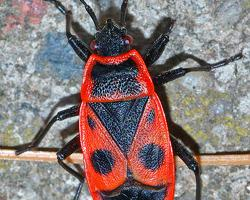
Váhy a míry
| Délka | od 10 do 12 mm |
|---|
Stav ohrožení
| Neohrožen |
Popis zvířete
The Firebug, scientifically known as Pyrrhocoris apterus, is a strikingly colored insect that belongs to the family Pyrrhocoridae. This small yet visually captivating creature is primarily found across Europe, extending its range into parts of Asia and North Africa. It has garnered attention not only for its bright appearance but also for its unique behaviors and adaptability to various environments.Characterized by a vivid red and black coloration, the Firebug's body is predominantly red with distinctive black markings. These markings include a black head, a black triangle on the thorax, and intricate black patterns on the wings. Despite being winged, Pyrrhocoris apterus is mostly flightless, with the wings typically not fully developed to enable flight. This feature, referred to as apterous, is reflected in its species name, 'apterus', indicating the absence of fully functional wings.
Adult Firebugs typically measure between 9 to 11 millimeters in length, making them relatively small but easily noticeable due to their bright colors. These colors are thought to serve as a warning to predators about their unpalatability, a common strategy among various brightly colored insects.
The Firebug thrives in a variety of habitats but shows a particular preference for areas with ample sunlight. It is commonly found in gardens, parks, and near human habitations, often congregating in large numbers. These insects are especially drawn to linden trees and mallows, feeding on the seeds of these plants. Their diet, primarily consisting of plant matter, occasionally includes dead or weak insects, showcasing their opportunistic feeding behavior.
One of the most fascinating aspects of the Firebug is its gregarious nature. These insects are often seen in large groups, especially during the mating season in spring. Such gatherings are not only for reproduction but also for feeding, where their collective behavior is believed to play a role in deterring predators.
The reproductive cycle of the Firebug begins with the laying of eggs in the soil or among leaf litter. The young bugs, known as nymphs, undergo a series of molts as they develop into adults. These nymphs resemble the adults in coloration but are smaller in size and lack fully developed wings. The development from egg to adult takes several weeks, with the Firebugs typically producing one to two generations per year, depending on the climate.
Despite their bright coloration and presence in human-dominated landscapes, Firebugs are generally harmless to humans and are not considered pests. Instead, their presence is often indicative of the health of the local ecosystem.
In summary, the Firebug, Pyrrhocoris apterus, is a small, brightly colored insect known for its distinctive red and black pattern, mostly flightless nature, and gregarious behavior. Found across a wide geographic range, these insects play a role in the ecosystem as seed feeders, with their life cycle and behaviors offering fascinating insights into the adaptability and survival strategies of insects in various environments.
Nové fotografie zvířat
Top 10 zvířat
- Chinese water dragon (Physignathus cocincinus)
- Galápagos tortoise (Geochelone nigra complex)
- Dolphin gull (Leucophaeus scoresbii)
- Japanese macaque (Macaca fuscata)
- Colombian red howler (Alouatta seniculus)
- Sea urchins (Echinoidea)
- Moustached guenon (Cercopithecus cephus)
- Diana monkey (Cercopithecus diana)
- Common reed warbler (Acrocephalus scirpaceus)
- Common house mosquito (Culex pipiens)